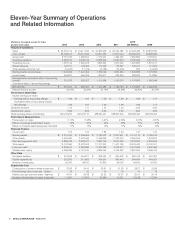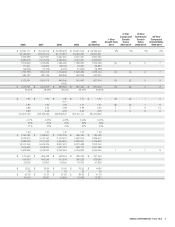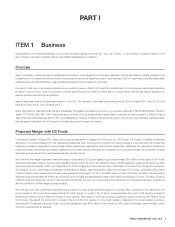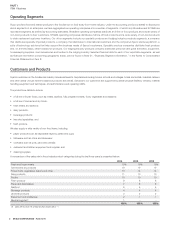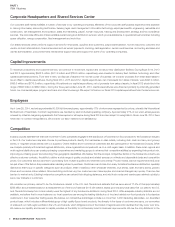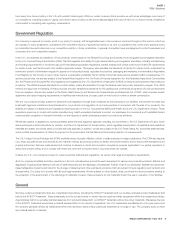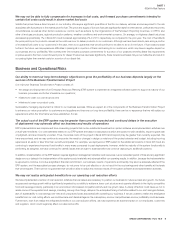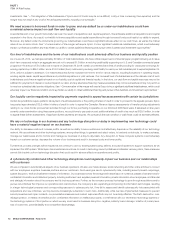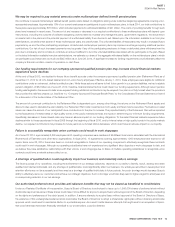Sysco 2014 Annual Report Download - page 18
Download and view the complete annual report
Please find page 18 of the 2014 Sysco annual report below. You can navigate through the pages in the report by either clicking on the pages listed below, or by using the keyword search tool below to find specific information within the annual report.
SYSCO CORPORATION-Form10-K6
PARTI
ITEM1ARisk Factors
We are not engaged in material research and development activities relating to the development of new products or the improvement of existing products.
Our sales do not generally uctuate signi cantly on a seasonal basis; therefore, the business of the company is not deemed to be seasonal.
As of June 28, 2014, we operated 194 distribution facilities throughout the U.S., Bahamas, Canada, Republic of Ireland and Northern Ireland.
ITEM1A Risk Factors
The following discussion of “risk factors” identi es the most signi cant factors that may adversely affect our business, operations, nancial position or future
nancial performance. This information should be read in conjunction with Management’s Discussion and Analysis of Financial Condition and Results of
Operations and the consolidated nancial statements and related notes contained in this report. The following discussion of risks is not all inclusive, but
is designed to highlight what we believe are the most signi cant factors to consider when evaluating our business. These factors could cause our future
results to differ from our expectations expressed in the forward-looking statements identi ed on page 44 and from historical trends.
Merger-Related Risks
The closing and consummation of the merger with US Foods, Inc. (US Foods) is subject to regulatory approval and the
satisfaction of certain conditions, and we cannot predict whether the necessary conditions will be satis ed or waived and
the requisite regulatory approvals received
The completion of the merger with US Foods is subject to regulatory approvals, including anti-trust approval, and customary conditions, including, without
limitation:
•the approval of the stockholders of US Foods;
•the expiration or termination of the applicable waiting period under the Hart-Scott-Rodino Antitrust Improvements Act of 1976, as amended;
•
the accuracy of the representations and warranties in the merger agreement and compliance with the respective covenants of the parties, subject to
certain quali ers;
•the absence of any law, proceeding, order or injunction that prohibits the consummation of the merger;
•the absence of certain governmental actions;
•the absence of a material adverse effect on US Foods; and
•the receipt by US Foods of a customary tax opinion with respect to the merger.
Sysco and US Foods may fail to secure the requisite approvals in a timely manner or on terms desired or anticipated, and the merger with US Foods may
not close in the anticipated time frame, if at all. Sysco has no control over certain conditions in the merger agreement, and cannot predict whether such
conditions will be satis ed or waived. Regulatory authorities may impose conditions on the completion of the merger or require changes to the terms of
the transaction. Such conditions or changes may prevent the closing of the merger or cause the merger to be delayed, and delays may cause Sysco to
incur additional, potentially burdensome transaction costs.
Sysco and US Foods may be required to accept certain remedies in order to obtain regulatory approval for the merger,
and any such remedies could reduce the projected bene ts of the merger and negatively impact the combined company
The imposition of remedies as a condition to obtaining regulatory approval for the transaction could limit the revenues of the combined company and
negatively impact the combined company. The potential remedies may negatively impact the projected bene ts of the proposed merger, along with the
business, nancial condition and competitiveness of Sysco, as the combined company. Even if regulatory approval for the merger is obtained, any remedies
could result in the total revenues of the combined post-merger entity being less than the combined historical revenues of Sysco and US Foods.
Termination of the merger agreement or failure to consummate the merger with US Foods could adversely impact
Sysco and, under certain conditions, could require Sysco to make a termination payment of $300 million, which could
adversely impact Sysco’s stock price and would adversely impact Sysco’s liquidity and nancial condition
The merger agreement contains certain termination rights, including the right of either party to terminate the merger agreement if the merger has not
occurred by March 8, 2015, subject to extension under certain circumstances. Furthermore, if the merger agreement is terminated due to a failure to obtain
required antitrust approvals, in certain circumstances Sysco will be required to pay US Foods a termination fee of $300 million. The payment of such fee
would have an adverse impact on our liquidity and nancial condition. In addition, if the merger agreement is terminated, we may suffer other negative


